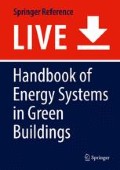Abstract
Smart building is based on the development of information technology. With certain controlling technologies integrated in buildings, it can help buildings achieve energy reduction and convenience. In this chapter, five main parts of smart building are introduced which are Building Automation System (BAS), Office Automation System (OAS), Communication Automation System (CAS), Generic Cabling System (GCS), and Building Management System (BMS). It also introduces the fundamentals of smart building including the classification of control system which are Operation Guiding System, Direct Digital Control System, Supervisory Computer Control System, Distribution Control System, and Fieldbus Control System. After the fundamentals, three smart building energy applications are discussed in the chapter which are demand-driven HVAC operation management, indoor localization-based smart building service, and home energy management systems. Finally, two cases about an office building and smart apartments are discussed as case study.
References
Lombard L, Ortiz J, Pout C (2008) A review on buildings energy consumption information. Energ Build 40(2):394–398
Li J, He J, Arora A (2011) ThermoNet: wireless solution for fine-grain building comfort-efficiency assessment. OSU-CISRC-10/11-TR33, Electronic report
Huang Q, Ge Z, Lu C (2016) Occupancy estimation in smart buildings using audio-processing techniques. In: International conference on computing in civil and building engineering. Osaka, pp 1413–1420
Greene N, Hand L (2014) Location-based services: an important building block to enhance the customer experience. White paper, CISCO
Huang Q, Zhang Y, Ge Z, Lu C (2016) Refining Wi-Fi based indoor localization with Li-Fi assisted model calibration in smart buildings. In: International conference on computing in civil and building engineering. Osaka, pp 1358–1365
Stamminger R, Broil G, Pakula C, Jungbecker H, Braun M, Rüdenauer I, Wendker C (2008) Synergy potential of smart appliances. Report of the smart-A project
Krystian XP, Michael B, Thomas FE (2016) Integrated HVAC management and optimal scheduling of smart appliances for community peak load reduction. Energ Build 123:34–40
Aduda KO, Labeodan T, Zeiler W, Boxem G, Zhao Y (2016) Demand side flexibility: potentials and building performance implications. Sustain Cities Soc 22:146–163
Aduda KO, Labeodan T, Zeiler W, Boxem G (2017) Demand side flexibility coordination in office buildings: a framework and case study application. Sustain Cities Soc 29:139–158
Author information
Authors and Affiliations
Corresponding author
Editor information
Editors and Affiliations
Section Editor information
Rights and permissions
Copyright information
© 2017 Springer-Verlag GmbH Germany
About this entry
Cite this entry
Yang, C. (2017). Smart Building Energy Systems. In: Wang, R., Zhai, X. (eds) Handbook of Energy Systems in Green Buildings. Springer, Berlin, Heidelberg. https://doi.org/10.1007/978-3-662-49088-4_29-1
Download citation
DOI: https://doi.org/10.1007/978-3-662-49088-4_29-1
Received:
Accepted:
Published:
Publisher Name: Springer, Berlin, Heidelberg
Print ISBN: 978-3-662-49088-4
Online ISBN: 978-3-662-49088-4
eBook Packages: Springer Reference EnergyReference Module Computer Science and Engineering

